Hypocrealean Fungi Associated with Hylobius abietis in Slovakia, Their Virulence against Weevil Adults and Effect on Feeding Damage in Laboratory
Abstract
1. Introduction
2. Materials and Methods
2.1. Collecting and Handling of Weevils
2.2. In Vitro Isolation and Identification of Entomopathogenic Fungi
2.3. Fungal Strains
2.4. Virulence Bioassays against H. abietis Adults
2.5. Feeding Damage Bioassay
2.6. Outdoor Bioassay with B. bassiana Treatment
2.7. Data Analysis
3. Results
3.1. Occurrence of Entomopathogenic Fungi in Populations of H. abietis
3.2. Virulence of Fungal Strains against H. abietis Adults
3.3. Feeding Damage Bioassay
3.4. Outdoor Bioassay with B. bassiana Treatment
4. Discussion
5. Conclusions
Author Contributions
Funding
Conflicts of Interest
References
- Leather, S.R.; Day, K.R.; Salisbury, A.N. The biology and ecology of the large pine weevil, Hylobius abietis (Coleoptera: Curculionidae): A problem of dispersal. B Entomol. Res. 1999, 89, 3–16. [Google Scholar] [CrossRef]
- Långström, B.; Day, K.R. Damage, control and management of weevil pests, especially Hylobius abietis. In Bark and Wood Boring Insects in Living Trees in Europe, A synthesis; Lieutier, F., Day, K.R., Battisti, A., Grégoire, J.C., Evans, H.F., Eds.; Springer: Dordrecht, The Netherlands, 2007; pp. 415–444. [Google Scholar] [CrossRef]
- Lempérière, G.; Mantilleri, A.; Conord, C. Taxonomy and systematics of bark weevils. In Bark and Wood Boring Insects in Living Trees in Europe, A synthesis; Lieutier, F., Day, K.R., Battisti, A., Grégoire, J.C., Evans, H.F., Eds.; Springer: Dordrecht, The Netherlands, 2007; pp. 317–330. [Google Scholar] [CrossRef]
- Zumr, V.; Starý, P. Monitoring of seasonal occurrence of Hylobius abietis (L.) (Col., Curculionidae) in different forest environments of a model area. J. Appl. Entomol. 1994, 118, 361–364. [Google Scholar] [CrossRef]
- Zumr, V.; Starý, P.; Dostálková, I. Monitoring of Hylobius abietis (L.) (Col., Curculionidae) populations by two types of baited pitfall traps. Anz. Schadlingsk. Pflanz. Umwelt. 1994, 67, 90–92. [Google Scholar] [CrossRef]
- Day, K.R.; Leather, S.R. Threats to forestry by insect pests in Europe. In Forests and Insects; Watt, A.D., Stork, N.E., Hunter, M.D., Eds.; Chapman & Hall: London, UK, 1997; pp. 177–205. [Google Scholar]
- Eidmann, H.H.; Lindelow, A. Estimates and measurements of pine weevil feeding on conifer seedlings: their relationships and application. Can. J. For. Res. 1997, 27, 1068–1073. [Google Scholar] [CrossRef]
- Solbreck, C. Dispersal distances of migrating pine weevils, Hylobius abietis, Coleoptera: Curculionidae. Entomol. Exp. Appl. 1980, 28, 123–131. [Google Scholar] [CrossRef]
- Månsson, P.E.; Schlyter, F. Hylobius pine weevils adult host selection and antifeedants: Feeding behaviour on host and non-host woody Scandinavian plants. Agric. For. Entomol. 2004, 6, 165–171. [Google Scholar] [CrossRef]
- Wallertz, K.; Nordenhem, H.; Nordlander, G. Damage by the pine weevil Hylobius abietis to seedlings of two native and five introduced tree species in Sweden. Silva. Fenn. 2014, 48, 1–14. [Google Scholar] [CrossRef]
- Day, K.R.; Nordlander, G.; Kenis, M.; Halldorson, G. General biology and life cycles of bark weevils. In Bark and Wood Boring Insects in Living Trees in Europe, A synthesis; Lieutier, F., Day, K.R., Battisti, A., Gregoire, J.C., Evans, H., Eds.; Springer: Dordrecht, The Netherlands, 2007; pp. 331–349. [Google Scholar] [CrossRef]
- Grégoire, J.C.; Evans, H.F. Damage and control of BAWBILT organisms an overview. In Bark and Wood Boring Insects in Living Trees in Europe, A synthesis; Lieutier, F., Day, K.R., Battisti, A., Gregoire, J.C., Evans, H., Eds.; Springer: Dordrecht, The Netherlands, 2007; pp. 19–37. [Google Scholar] [CrossRef]
- Galko, J.; Gubka, A.; Vakula, J. Praktické skúsenosti s využitím lapacích kôr na zníženie škôd spôsobených tvrdoňom smrekovým na mladých výsadbách ihličnatých drevín (Experience with pine weevils trapping by bark pieces to reduce damage on conifer saplings). In Proceedings of the Aktuálne Problémy V Ochrane Lesa 2012, Nový Smokovec, Slovakia, 12–13 April 2012; Kunca, A., Ed.; National Forest Centre: Zvolen, Slovakia, 2012; pp. 60–64. (In Slovak). [Google Scholar]
- Galko, J.; Ondruš, J.; Rell, S.; Gubka, A.; Vakula, J. Využitie lapacích kôr pri monitoringu populačnej hustoty tvrdoňa smrekového a lykokazov rodu Hylastes (The use of trapping bark pieces in monitoring of population density of pine weevil and Hylastes bark beetles). In Proceedings of the Aktuálne Problémy V Ochrane Lesa 2013, Nový Smokovec, Slovakia, 25–26 April 2013; Kunca, A., Ed.; National Forest Centre: Zvolen, Slovakia, 2013; pp. 142–145. (In Slovak). [Google Scholar]
- Rell, S.; Galko, J.; Lalík, M. Mechanické spôsoby ochrany sadeníc proti škodám spôsobeným zrelostným žerom tvrdoňa smrekového (Hylobius abietis L.) (Mechanical measures in saplings protection against damage by the large pine weevil (Hylobius abietis L.)). In Proceedings of the Aktuálne Problémy V Ochrane Lesa 2017, Nový Smokovec, Slovakia, 26–27 January 2017; Kunca, A., Ed.; National Forest Centre: Zvolen, Slovakia, 2017; pp. 151–155. (In Slovak). [Google Scholar]
- Zumr, V.; Starý, P. LATEX paint as an antifeedant against Hylobius abietis (L.) (Col, Curculionidae) on conifer seedlings. Anz. Schadlingsk. Pflanz. Umwelt. 1995, 68, 42–43. [Google Scholar] [CrossRef]
- Hagner, M.; Jonsson, C. Survival after planting without soil preparation for pine and spruce seedlings protected from Hylobius abietis by physical and chemical shelters. Scan. J. Forest Res. 1995, 10, 225–234. [Google Scholar] [CrossRef]
- Eidmann, H.H.; Nordenhem, H.; Weslien, J. Physical protection of conifer seedlings against pine weevil feeding. Scan. J. For. Res. 1996, 11, 68–75. [Google Scholar] [CrossRef]
- Örlander, G.; Nilsson, U. Effects of reforestation methods on pine weevil (Hylobius abietis) damage and seedling survival. Scand. J. For. Res. 1999, 14, 341–354. [Google Scholar] [CrossRef]
- Örlander, G.; Nordlander, G. Effects of field vegetation control on pine weevil (Hylobius abietis) damage to newly planted Norway spruce seedlings. Ann. For. Sci. 2003, 60, 667–671. [Google Scholar] [CrossRef]
- Nordlander, G.; Nordenhem, H.; Hellqvist, C. A flexible sand coating (Conniflex) for the protection of conifer seedlings against damage by the pine weevil, Hylobius abietis. Agric. For. Entomol. 2009, 11, 91–100. [Google Scholar] [CrossRef]
- Galko, J.; Rell, S.; Kunca, A. Testovanie odolnosti voskom ošetrených sadeníc pred zrelostným žerom tvrdoňa smrekového—Súčasný stav a výskum na LOS (Resistance of wax-treated seedlings to maturation feeding of large pine weevil - current status and research at FPSC). In Proceedings of the Aktuálne problémy v ochrane lesa 2016, Nový Smokovec, Slovakia, 21–22 January 2016; Kunca, A., Ed.; National Forest Centre: Zvolen, Slovakia, 2016; pp. 165–170. (In Slovak). [Google Scholar]
- Willoughby, I.; Moore, R.; Nisbet, T. Interim Guidance on the Integrated Management of Hylobius Abietis in UK Forestry; The Research Agency of the Forestry Commission: Bristol, UK, 2017; p. 28. [Google Scholar]
- Modlinger, R.; Lalík, M.; Galko, J.; Lubojacký, J. Ověření ochrany výsadeb proti žíru klikoroha borového (Hylobius abietis) pomocí voskování v terénních podmínkách (Evaluation of seedlings protection against the bark beetle (Hylobius abietis) by waxing in field conditions). In Aktuálne problémy v ochrane lesa 2018, Proceedings of papers, Nový Smokovec, Slovakia, 1–2 February 2018; Kunca, A., Ed.; National Forest Centre: Zvolen, Slovakia, 2018; pp. 68–72. (In Czech) [Google Scholar]
- Rell, S.; Galko, J.; Lalík, M. Porovnanie ošetrenia smrekových sadeníc lepom a Pellacolom proti škodám spôsobeným tvrdoňom smrekovým (Hylobius abietis) (Comparison of spruce seedlings treatment with adhesive and Pellacol against damage caused by spruce bark (Hylobius abietis)). In Proceedings of the Aktuálne problémy v ochrane lesa 2018, Nový Smrekovec, Slovakia, 1–2 February 2018; Kunca, A., Ed.; National Forest Centre: Zvolen, Slovakia, 2018; pp. 101–104. (In Slovak). [Google Scholar]
- Rose, D. Control of the Large Pine Weevil, Hylobius abietis, L. Ph.D. Thesis, Imperial College at Silwood Park Ascot, Berkshire, UK, September 2002. [Google Scholar]
- Olenici, N.; Bouriaud, O.; Manea, I.A. Efficient conifer seedling protection against pine weevil damage using neonicotinoids. Balt. For. 2018, 24, 201–209. [Google Scholar]
- Gubka, A.; Kunca, A.; Vakula, J.; Galko, J.; Nikolov, Ch.; Rell, S.; Zúbrik, M.; Leontovyč, R. Máme vysokú spotrebu pesticídov? (Do we have high pesticide usage?). In Proceedings of the Aktuálne problémy v ochrane lesa 2017, Nový Smrekovec, Slovakia, 26–27 January 2017; Kunca, A., Ed.; National Forest Centre: Zvolen, Slovakia, 2017; pp. 103–109. [Google Scholar]
- Brixey, J.M.; Moore, R.; Milner, A.D. Effect of entomopathogenic nematode (Steinernema carpocapsae Weiser) application technique on the efficacy and distribution of infection of the large pine weevil (Hylobius abietis L.) in stumps of Sitka spruce (Picea sitchensis Carr.) created at different times. For. Ecol. Manag. 2006, 226, 161–172. [Google Scholar] [CrossRef]
- Dillon, A.B.; Ward, D.; Downes, M.J.; Griffin, C.T. Suppression of the large pine weevil Hylobius abietis (L.) (Coleoptera: Curculionidae) in pine stumps by entomopathogenic nematodes with different foraging strategies. Biol. Control 2006, 38, 217–226. [Google Scholar] [CrossRef]
- Purrini, K. Nosema hylobii n. sp. (Nosematidae, Microsporida), a new microsporidian parasite of Hylobius abietis L. (Curculionidae, Coleoptera). Z. Angew. Entomol. 2009, 92, 1–8. [Google Scholar] [CrossRef]
- Williams, C.D.; Dillon, A.B.; Harvey, C.D.; Hennessy, R.; Mc Namara, L.; Griffin, C.T. Control of a major pest of forestry, Hylobius abietis, with entomopathogenic nematodes and fungi using eradicant and prophylactic strategies. For. Ecol. Manag. 2013, 305, 212–222. [Google Scholar] [CrossRef]
- Harvey, C.D.; Griffin, C.T. Local host-dependent persistence of the entomopathogenic nematode Steinernema carpocapsae used to control the large pine weevil Hylobius abietis. BioControl 2016, 61, 185–193. [Google Scholar] [CrossRef]
- Kapranas, A.; Malone, B.; Quinn, S.; Mc Namara, L.; Williams, C.D.; O’Tuama, P.; Peters, A.; Griffin, C.T. Efficacy of entomopathogenic nematodes for control of large pine weevil, Hylobius abietis: Effects of soil type, pest density and spatial distribution. J. Pest. Sci. 2017, 90, 495–505. [Google Scholar] [CrossRef]
- Wegensteiner, R.; Tkaczuk, C.; Bałazy, S.; Griesser, S.; Rouffaud, M.A.; Stradner, A.; Steinwender, B.M.; Hager, H.; Papierok, B. Occurrence of pathogens in populations of Ips typographus, Ips sexdentatus (Coleoptera, Curculionidae, Scolytinae) and Hylobius spp. (Coleoptera, Curculionidae, Curculioninae) from Austria, Poland and France. Acta Protozool. 2015, 3, 219–232. [Google Scholar] [CrossRef]
- Ansari, M.A.; Butt, T.M. Susceptibility of different developmental stages of large pine weevil Hylobius abietis (Coleoptera: Curculionidae) to entomopathogenic fungi and effect of fungal infection to adult weevils by formulation and application methods. J. Invertebr. Pathol. 2012, 111, 33–40. [Google Scholar] [CrossRef] [PubMed]
- Vega, F.E.; Meyling, N.V.; Luangsa-Ard, J.J.; Blackwell, M. Chapter 6—Fungal Entomopathogens. In Insect Pathology; Vega, F.E., Kaya, H.K., Eds.; Academic Press: San Diego, CA, USA, 2012; pp. 171–220. [Google Scholar] [CrossRef]
- Lacey, L.A.; Grzywacz, D.; Shapiro-Ilan, D.I.; Frutos, R.; Brownbridge, M.; Goettel, M.S. Insect pathogens as biological control agents: Back to the future. J. Invertebr. Pathol. 2015, 132, 1–41. [Google Scholar] [CrossRef] [PubMed]
- De Faria, M.R.; Wraight, S.P. Mycoinsecticides and mycoacaricides: A comprehensive list with worldwide coverage and international classification of formulation types. Biol. Control 2007, 43, 237–256. [Google Scholar] [CrossRef]
- Reddy, K.R.K.; Praveen Kumar, D.; Reddy, K.R.N. Entomopathogenic fungi: A potential bioinsecticide. Kavaka 2013, 41, 23–32. [Google Scholar]
- Zimmermann, G. Review on safety of the entomopathogenic fungi Beauveria bassiana and Beauveria brongniartii. Biocontrol. Sci. Techn. 2007, 17, 553–596. [Google Scholar] [CrossRef]
- Jaronski, S.T. Mass production of entomopathogenic fungi: State of the art. In Mass Production of Beneficial Organisms; Morales-Ramos, J., Rojas, M.G., Shapiro-Ilan, D., Eds.; Academic Press: Amsterdam, The Netherlands, 2014; pp. 357–413. [Google Scholar]
- Augustyniuk-Kram, A.; Kram, K.J. Entomopathogenic fungi as an important natural regulator of insect outbreaks in forests (Review). In Forest Ecosystems—More than Just Trees; Blanco, J.A., Lo, Y.H., Eds.; InTech Press: Rijeka, Croatia, 2012; pp. 265–294. [Google Scholar]
- Gerdin, S. Observations on pathogens and parasites of Hylobius abietis (Coleoptera: Curculionidae) in Sweden. J. Invertebr. Pathol. 1977, 30, 263–264. [Google Scholar] [CrossRef]
- Glare, T.R.; Reay, S.D.; Nelson, T.L.; Moore, R. Beauveria caledonica is a naturally occurring pathogen of forest beetles. Mycol. Res. 2008, 112, 352–360. [Google Scholar] [CrossRef]
- Samsinakova, A.; Novák, V. Eine Methode zur integrierten Bekämpfung des Rüsselkäfers (Hylobius abietis L.). Anz. Schadlingsk. Pflanz. Umwelt. 1967, 40, 22–27. [Google Scholar]
- Waldenfels, J. Versuche zur Bekämpfung von Hylobius abietis L. (Coleopt., Curculionidae). Anz. Schadlingsk. Pflanz. Umwelt. 1975, 48, 21–25. [Google Scholar] [CrossRef]
- Wegensteiner, R.; Führer, E. Zur Wirksamkeit von Beauveria bassiana (Bals.) Vuill. gegen Hylobius abietis L. (Col.: Curculionidae). Entomophaga 1988, 33, 339–348. [Google Scholar] [CrossRef]
- Wegensteiner, R. The efficacy of Beauveria bassiana, B. brongniartii and B. tenella against Hylobius abietis (Col., Curcul.). In Proceedings of the International Conference on Biopesticides, Theory and Practice, České Budějovice, Czechoslovakia, 25–28 September 1989; Jegorov, A., Matha, V., Eds.; Czechoslovak Academy of Sciences: České Budějovice, Czechoslovakia, 1989; pp. 238–242. [Google Scholar]
- Mc Namara, L.; Kapranas, A.; Williams, C.D.; O’Tuama, P.; Kavanagh, K.; Griffin, C.T. Efficacy of entomopathogenic fungi against large pine weevil, Hylobius abietis, and their additive effects when combined with entomopathogenic nematodes. J. Pest. Sci. 2018, 91, 1407–1419. [Google Scholar] [CrossRef]
- Zumr, V.; Starý, P. The occurrence of the large pine weevil, Hylobius abietis (L.), in individual forest zones. For. Ecol. Manag. 1992, 51, 251–258. [Google Scholar] [CrossRef]
- Voolma, K.; Sibul, I. The effect of collecting fluid on the catch results of Hylobius abietis in pitfall traps. Agron. Res. 2006, 4, 457–460. [Google Scholar]
- Humber, R.A. Identification of entomopathogenic fungi. In Manual of Techniques in Invertebrate Pathology; Lacey, L.A., Ed.; Academic Press: Amsterdam, The Netherlands, 2012; pp. 151–187. [Google Scholar]
- Rehner, S.A.; Buckley, E.P. A Beauveria phylogeny inferred from ITS and EF1-α sequences: evidence for cryptic diversification and links to Cordyceps teleomorphs. Mycologia 2005, 97, 84–98. [Google Scholar] [CrossRef] [PubMed]
- Rehner, S.A.; Minnis, A.M.; Sung, G.H.; Luangsa-ard, J.J.; Devotto, L.; Humber, R.A. Phylogeny and systematics of the anamorphic, entomopathogenic genus Beauveria. Mycologia 2011, 103, 1055–1073. [Google Scholar] [CrossRef]
- White, T.J.; Bruns, T.; Lee, S.; Taylor, J. Amplification and direct sequencing of fungal ribosomal RNA genes for phylogenetics. In PCR Protocols: A Guide to Methods and Applications; Innis, M.A., Gelfand, D.H., Sninsky, J.J., White, T.J., Eds.; Academic Press: San Diego, CA, USA, 1990; pp. 315–322. [Google Scholar]
- Gardes, M.; Bruns, T.D. ITS primers with enhanced specificity for Basidiomycetes: application to identification of mycorrhizae and rusts. Mol. Ecol. 1993, 2, 113–118. [Google Scholar] [CrossRef] [PubMed]
- Altschul, S.F.; Madden, T.L.; Schaffer, A.A.; Zhang, J.; Zhang, Z.; Miller, W.; and Lipman, D.J. Gapped BLAST and PSI-BLAST: A new generation of protein database search programs. Nucleic Acids Res. 1997, 25, 3389–3402. [Google Scholar] [CrossRef]
- Barta, M. Pathogenicity assessment of entomopathogenic fungi infecting Leptoglossus occidentalis (Heteroptera: Coreidae). Czech. Mycol. 2010, 62, 67–78. [Google Scholar] [CrossRef]
- Leather, S.R.; Ahmed, S.I.; Hogan, L. Adult feeding preferences of the large pine weevil, Hylobius abietis (Coleoptera: Curculionidae). Eur. J. Entomol. 1994, 91, 385. [Google Scholar]
- Robertson, J.L.; Jones, M.M.; Olguin, E.; Alberts, B. Bioassays with Arthropods, 3rd ed.; CRC Press: Boca Raton, FL, USA, 2017; p. 194. [Google Scholar]
- Medo, J.; Michalko, J.; Medová, J.; Cagáň, Ľ. Phylogenetic structure and habitat associations of Beauveria species isolated from soils in Slovakia. J. Invertebr. Pathol. 2016, 140, 46–50. [Google Scholar] [CrossRef] [PubMed]
- Popowska-Nowak, E.; Skrzecz, I.; Tumialis, D.; Pezowicz, E.; Samborska, I.; Góral, K. Entomopathogenic fungi in the soils of forest plantations: towards the control of large pine weevil, Hylobius Abietis. Balt. For. 2016, 22, 8–15. [Google Scholar]
- Bisset, J.; Widden, P. A new species of Beauveria isolated from Scottish moorland soil. Can. J. Bot. 1988, 66, 361–362. [Google Scholar] [CrossRef]
- Reay, S.D.; Brownbridge, M.; Cummings, N.J.; Nelson, T.L.; Souffre, B.; Lignon, C.; Glare, T.R. Isolation and characterization of Beauveria spp. associated with exotic bark beetles in New Zealand Pinus radiata plantation forests. Biol. Control. 2008, 46, 484–494. [Google Scholar] [CrossRef]
- Barta, M.; Kautmanová, I.; Čičková, H.; Ferenčík, J.; Florián, Š.; Novotný, J.; Kozánek, M. Hypocrealean fungi associated with populations of Ips typographus in West Carpathians and selection of local Beauveria strains for effective bark beetle control. Biologia 2018, 73, 53–65. [Google Scholar] [CrossRef]
- Markova, G. Pathogenicity of several entomogenous fungi to some of the most serious forest insect pest in Europe. IOBC/WPRS Bull. 2000, 23, 231–239. [Google Scholar]
- Zhang, S.L.; He, L.M.; Chen, X.; Hueng, B. Beauveria lii sp. nov. isolated from Henosepilachna vigintioctopunctata. Mycotaxon 2012, 121, 199–206. [Google Scholar] [CrossRef]
- Chen, M.J.; Huang, B.; Li, Z.; Spatafora, J.W. Morphological and genetic characterisation of Beauveria sinensis sp. nov. from China. Mycotaxon 2013, 124, 301–308. [Google Scholar] [CrossRef]
- Chen, W.H.; Han, Y.F.; Liang, Z.Q.; Jin, D.C. A new araneogenous fungus in the genus Beauveria from Guizhou, China. Phytotaxa 2017, 302, 57–64. [Google Scholar] [CrossRef]
- Agrawal, Y.; Mual, P.; Shenoy, B.D. Multi-gene genealogies reveal cryptic species Beauveria rudraprayagi sp. nov. from India. Mycosphere 2014, 5, 719–736. [Google Scholar] [CrossRef]
- Ariyawansa, H.A.; Hyde, K.D.; Jayasiri, S.C.; Buyck, B.; Chethana, K.W.T. Fungal diversity notes 111–252—taxonomic and phylogenetic contributions to fungal taxa. Fungal Divers. 2015, 75, 27–274. [Google Scholar] [CrossRef]
- Robène-Soustrade, I.; Jouen, E.; Pastou, D.; Payet-Hoarau, M.; Goble, T.; Linderme, D.; Lefeuvre, P.; Calmès, C.; Reynaud, B.; Nibouche, S.; et al. Description and phylogenetic placement of Beauveria hoplocheli sp. nov. used in the biological control of the sugarcane white grub, Hoplochelus marginalis, on Reunion Island. Mycologia 2015, 107, 1221–1232. [Google Scholar] [CrossRef] [PubMed]
- Imoulan, A.; Wu, H.J.; Lu, W.L.; Li, Y.; Li, B.B.; Yang, R.H.; Wang, W.J.; Wang, X.L.; Kirk, P.M.; Yao, Y.J. Beauveria medogensis sp. nov., a new fungus of the entomopathogenic genus from China. J. Invertebr. Pathol. 2016, 139, 74–81. [Google Scholar] [CrossRef] [PubMed]
- Girling, R.D.; Ennis, D.; Dillon, A.B.; Griffin, C.T. The lethal and sub-lethal consequences of entomopathogenic nematode infestation and exposure for adult pine weevils, Hylobius abietis (Coleoptera: Curculionidae). J. Invertebr. Pathol. 2010, 104, 195–202. [Google Scholar] [CrossRef] [PubMed]
- Eidmann, H.H. Integrated management of pine weevil (Hylobius abietis L.) populations in Sweden. In Current Topics in Forest Entomology; Forest Service General Technical Report WO-8; USDA: Washington, DC, USA, 1979; pp. 103–109. [Google Scholar]
- Christiansen, E. Laboratory study on factors influencing pre-imaginal development in Hylobius abietis L. (Col., Curculionidae). Norsk Entomol. Tidsskr. 1971, 18, 1–8. [Google Scholar]
- Christiansen, E.; Bakke, A. Temperature preference in adults of Hylobius abietis L. (Coleoptera: Curculionidae) during feeding and oviposition. Z. Angew. Entomol. 1968, 62, 83–89. [Google Scholar] [CrossRef]
- Wainhouse, D.; Boswell, R.; Ashburner, R. Maturation feeding and reproductive development in adult pine weevil, Hylobius abietis (Coleoptera Curculionidae). B Entomol. Res. 2004, 94, 81–87. [Google Scholar] [CrossRef]
- Gardner, W.A.; Sutton, R.M.; Noblet, R. Persistence of Beauveria bassiana, Nomuraea rileyi, and Nosema necatrix on soybean foliage. Environ. Entomol. 1977, 6, 616–618. [Google Scholar] [CrossRef]
- Huang, B.F.; Feng, M.G. Comparative tolerances of various Beauveria bassiana isolates to UV-B irradiation with a description of a modeling method to assess lethal dose. Mycopathologia 2009, 168, 145–152. [Google Scholar] [CrossRef]
- Posadas, J.B.; Angulo, L.M.; Mini, J.I.; Lecuona, R.E. Natural tolerance to UV-B and assessment of photoprotectants in conidia of six native isolates of Beauveria bassiana (Bals-Criv) Vuillemin. World Appl. Sci. J. 2012, 20, 1024–1030. [Google Scholar] [CrossRef]
- Ignoffo, C.M.; Garcia, C.; Hostetter, D.L.; Pinnell, R.E. Vertical movement of conidia of Nomuraea rileyi through sand and loam soils. J. Econ. Entomol. 1977, 70, 163–164. [Google Scholar] [CrossRef]
- Fargues, J.; Goettel, M.S.; Smits, N.; Ouedraogo, A.; Vidal, C.; Lacey, L.A.; Lomer, C.J.; Rougier, M. Variability in susceptibility to simulated sunlight of conidia among isolates of entomopathogenic Hyphomycetes. Mycopathologia 1996, 135, 171–181. [Google Scholar] [CrossRef] [PubMed]
- Morley-Davies, J.; Moore, D.; Prior, C.J. Screening of Metarhizium and Beauveria spp. conidia with exposure to simulated sunlight and a range of temperatures. Mycol. Res. 1995, 100, 31–38. [Google Scholar] [CrossRef]
- Kouassi, M.; Coderre, D.; Todorova, S.I. Effect of plant type on the persistence of Beauveria bassiana. Biocontrol Sci. Techn. 2003, 13, 415–427. [Google Scholar] [CrossRef]
- Inglis, G.D.; Goettel, M.S.; Johnson, D.L. Persistence of the entomopathogenic fungus, Beauveria bassiana, on phylloplanes of crested wheatgrass and alfalfa. Biol. Control 1993, 3, 258–270. [Google Scholar] [CrossRef][Green Version]
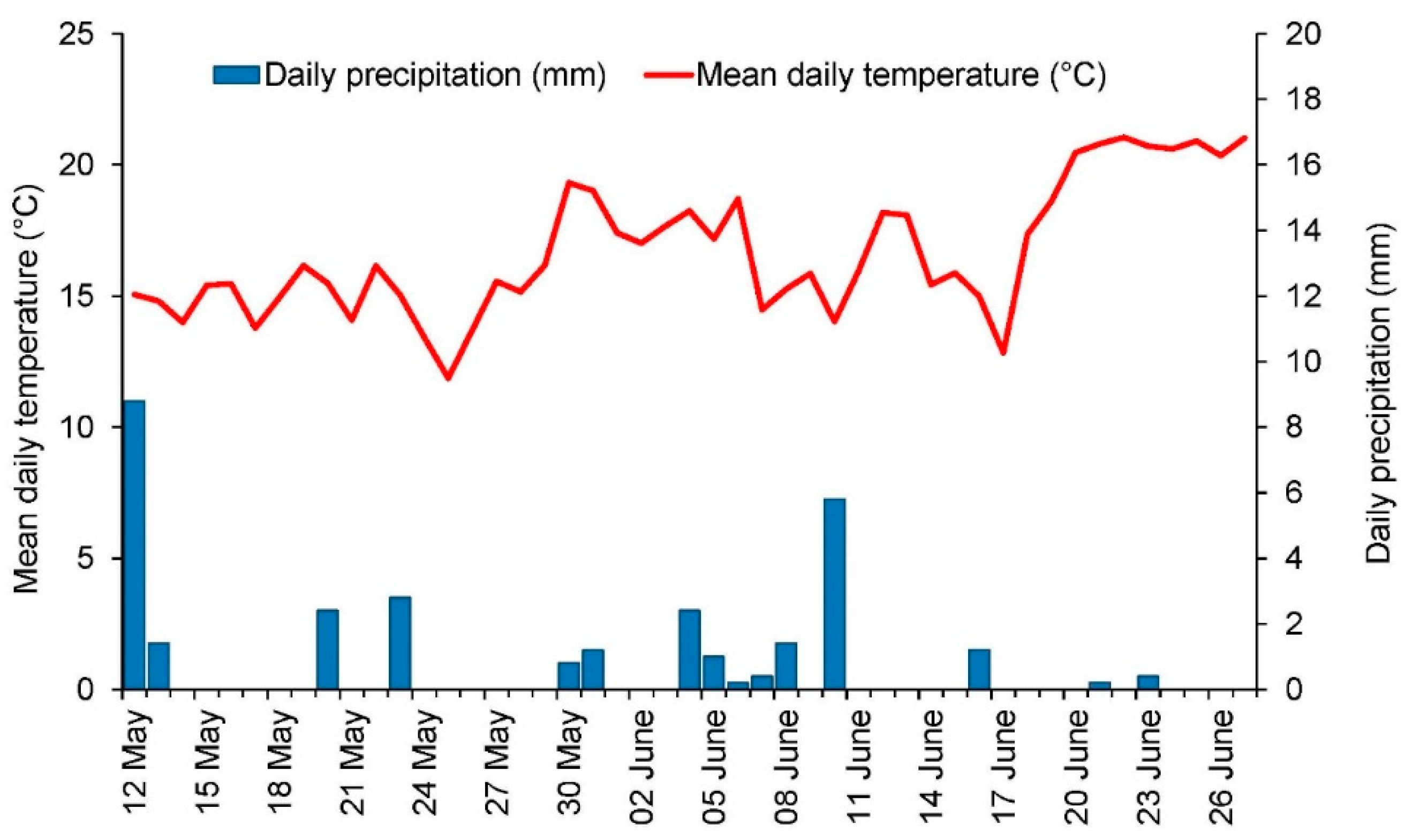
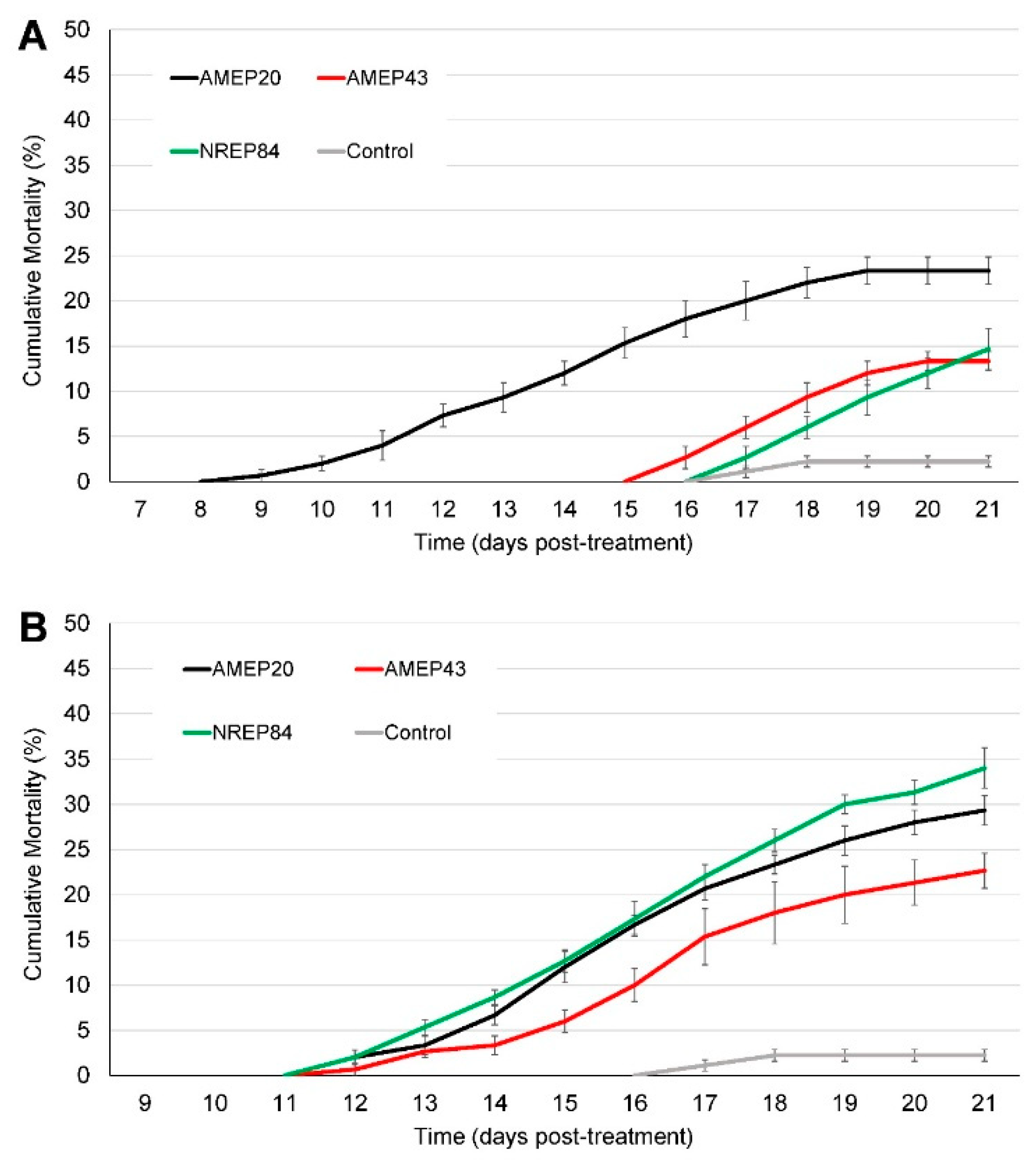
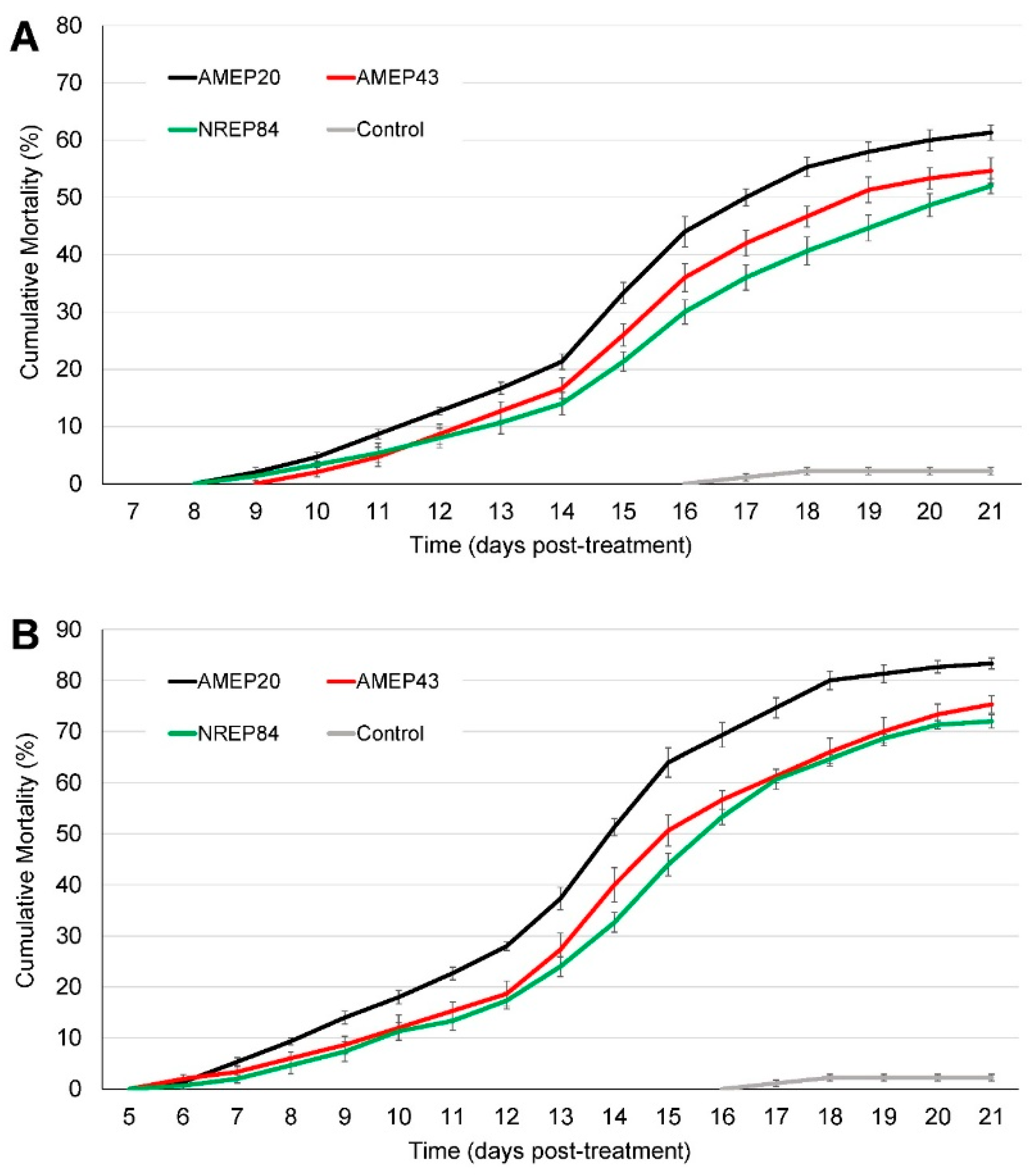
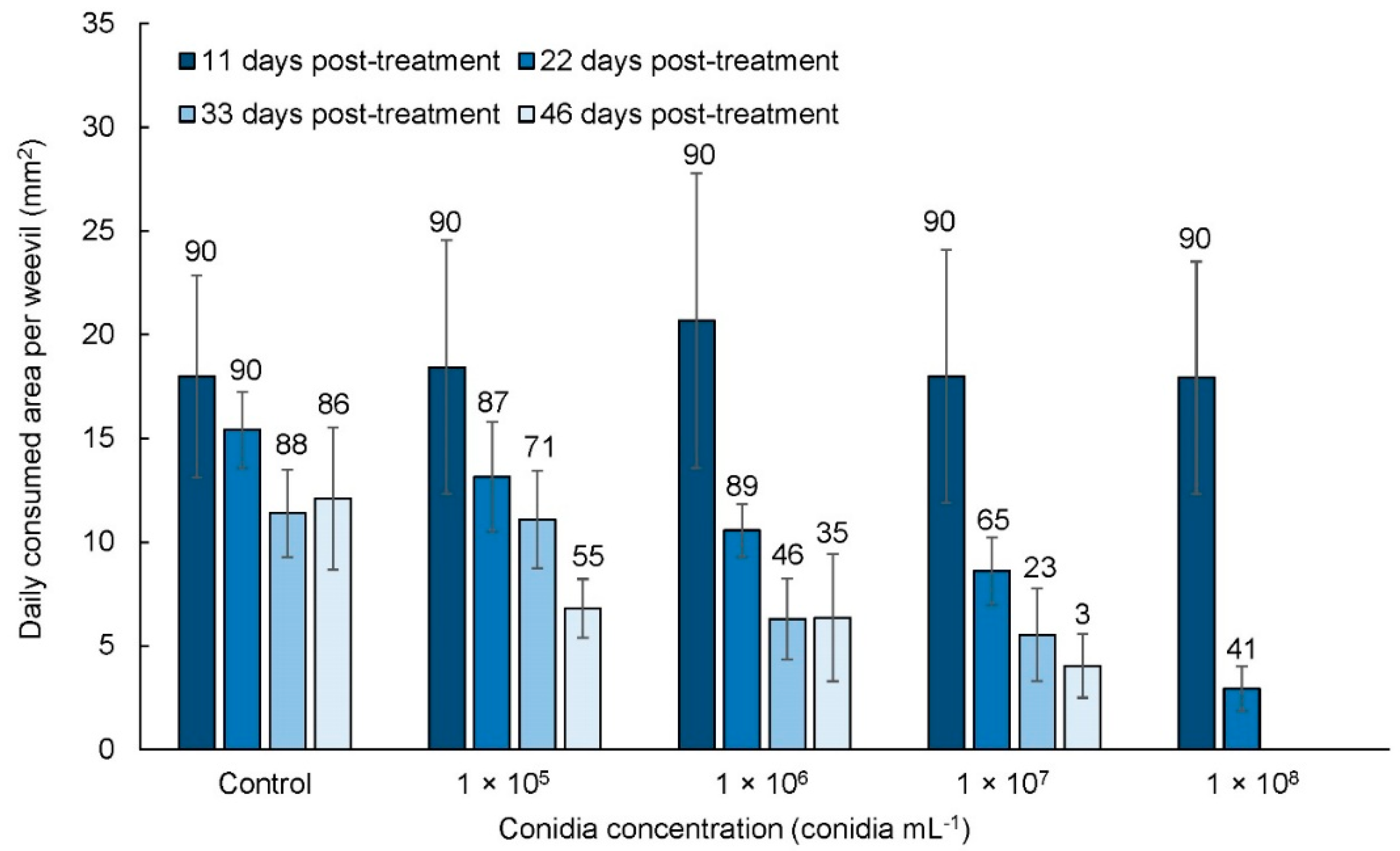
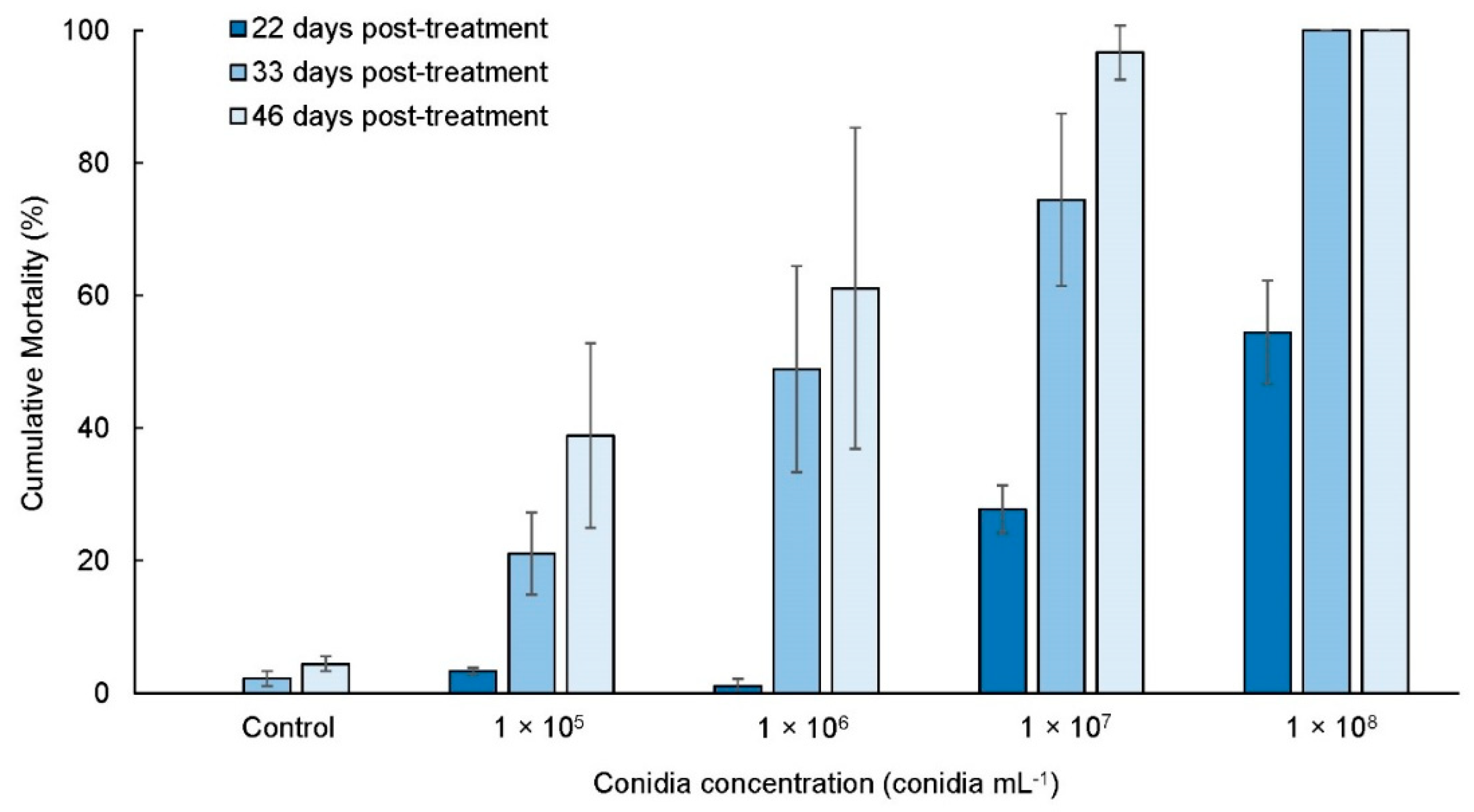
| Strain | Fungal Species | GenBank Accession No. 1 | |
|---|---|---|---|
| ITS | TEF-1α | ||
| AMEP020 | Beauveria bassiana | MK490859 | MK504338 |
| AMEP043 | Beauveria pseudobassiana | MK490860 | MK504354 |
| AMEP052 | Beauveria bassiana | MK490861 | MK504339 |
| AMEP053 | Beauveria bassiana | MK490862 | MK504340 |
| AMEP056 | Beauveria bassiana | MK490863 | MK504341 |
| AMEP067 | Beauveria pseudobassiana | MK490864 | MK504355 |
| AMEP072 | Beauveria bassiana | MK490865 | MK504342 |
| NREP083 | Beauveria pseudobassiana | MK490866 | MK504356 |
| NREP084 | Beauveria pseudobassiana | MK490867 | MK504357 |
| NREP087 | Beauveria bassiana | MK490868 | MK504343 |
| NREP088 | Beauveria bassiana | MK490869 | MK504344 |
| NREP090 | Beauveria bassiana | MK490870 | MK504345 |
| NREP091 | Beauveria bassiana | MK490871 | MK504346 |
| NREP094 | Beauveria bassiana | MK490872 | MK504347 |
| NREP095 | Beauveria bassiana | MK490873 | MK504348 |
| NREP096 | Beauveria bassiana | MK490874 | MK504349 |
| NREP097 | Beauveria bassiana | MK490875 | MK504350 |
| NREP098 | Beauveria bassiana | MK490876 | MK504351 |
| NREP099 | Beauveria pseudobassiana | MK490877 | MK504358 |
| NREP100 | Beauveria bassiana | MK490878 | MK504352 |
| NREP102 | Beauveria bassiana | MK490879 | MK504353 |
| NREP103 | Beauveria pseudobassiana | MK490880 | MK504359 |
| Strain | Sex | LC50 ± SE 1 × 108 | 95% Fiducial Confidence Interval 1 | Slope ± SE 2 | LC50 Ratio 3 | 95% Confidence Interval 3 |
|---|---|---|---|---|---|---|
| AMEP20 | M | 0.52 ± 0.03 | 0.07–1.71 | 0.36 ± 0.10 | 38.42 | 0.24–610 |
| F | 0.78 ± 0.06 | 0.08–4.30 | 0.29 ± 0.09 | |||
| AMEP43 | M | 1.05 ± 0.12 | 0.22–3.17 | 0.42 ± 0.11 | 2.52 | 0.10–62.46 |
| F | 1.07 ± 0.10 | 0.21–3.51 | 0.40 ± 0.11 | |||
| AMEP52 | M | 1.88 ± 0.11 | 0.04–8.56 | 0.39 ± 0.12 | 0.88 | 0.02–47.75 |
| F | 2.23 ± 0.14 | 0.06–11.56 | 0.36 ± 0.10 | |||
| AMEP53 | M | 6.89 ± 0.40 | 0.18–107.91 | 0.56 ± 0.23 | 1.60 | 0.01–307 |
| F | 5.51 ± 0.40 | 0.16–71.72 | 0.40 ± 0.12 | |||
| AMEP56 | M | 8.07 ± 0.89 | 0.13–904.89 | 0.31 ± 0.13 | 98.44 | 0.08–1059 |
| F | 9.79 ± 0.13 | 0.14–736.54 | 0.25 ± 0.11 | |||
| AMEP67 | M | 4.21 ± 0.35 | 0.08–136.59 | 0.34 ± 0.13 | 2.17 | 0.01–1235 |
| F | 4.29 ± 0.37 | 0.09–130.50 | 0.30 ± 0.10 | |||
| AMEP72 | M | 10.28 ± 0.70 | 0.27–316.51 | 0.58 ± 0.29 | 1.03 | 0.01–812 |
| F | 8.12 ± 0.73 | 0.19–470.10 | 0.36 ± 0.12 | |||
| NREP83 | M | 3.15 ± 0.19 | 0.08–16.75 | 0.43 ± 0.14 | 14.10 | 0.01–425 |
| F | 1.93 ± 0.13 | 0.05–11.16 | 0.34 ± 0.10 | |||
| NREP84 | M | 1.01 ± 0.19 | 0.09–8.46 | 0.27 ± 0.10 | 1.24 | 0.02–88.43 |
| F | 0.76 ± 0.05 | 0.11–3.10 | 0.33 ± 0.10 | |||
| NREP87 | M | 4.97 ± 0.28 | 0.13–35.86 | 0.52 ± 0.20 | 4.16 | 0.03–676 |
| F | 4.36 ± 0.34 | 0.11–69.33 | 0.34 ± 0.11 | |||
| NREP88 | M | 11.73 ± 0.14 | 0.20–306.56 | 0.34 ± 0.16 | 0.49 | 0.01–162 |
| F | 13.28 ± 0.16 | 0.25–226.92 | 0.32 ± 0.12 | |||
| NREP90 | M | 10.28 ± 0.70 | 0.27–313.53 | 0.58 ± 0.29 | 1.63 | 0.02–129 |
| F | 10.34 ± 0.88 | 0.27–451.33 | 0.41 ± 0.14 | |||
| NREP91 | M | 4.03 ± 0.22 | 0.11–18.29 | 0.51 ± 0.17 | 1.09 | 0.07–16.33 |
| F | 2.04 ± 0.11 | 0.06–7.90 | 0.41 ± 0.11 | |||
| NREP94 | M | 2.66 ± 0.16 | 0.58–12.42 | 0.44 ± 0.15 | 1.43 | 0.06–36.95 |
| F | 2.23 ± 0.14 | 0.06–11.56 | 0.36 ± 0.10 | |||
| NREP95 | M | 8.32 ± 0.50 | 0.26–83.23 | 0.59 ± 0.21 | 1.05 | 0.10–11.27 |
| F | 6.45 ± 0.38 | 0.22–41.89 | 0.50 ±0 .15 | |||
| NREP96 | M | 2.17 ± 0.16 | 0.04–18.66 | 0.33 ± 0.11 | 0.62 | 0.01–35.02 |
| F | 1.96 ± 0.13 | 0.05–11.76 | 0.33 ± 0.10 | |||
| NREP97 | M | 5.09 ± 0.43 | 0.10–303.90 | 0.35 ± 0.14 | 3.45 | 0.18–65.89 |
| F | 6.53 ± 0.63 | 0.14–584.54 | 0.31 ± 0.11 | |||
| NREP98 | M | 3.00 ± 0.17 | 0.07–132.97 | 0.47 ± 0.15 | 38.98 | 0.01–208 |
| F | 2.63 ± 0.18 | 0.07–190.81 | 0.36 ± 0.11 | |||
| NREP99 | M | 9.88 ± 0.59 | 0.29–117.43 | 0.65 ± 0.29 | 68.92 | 0.05–886 |
| F | 5.75 ± 0.37 | 0.18–481.19 | 0.45 ± 0.14 | |||
| NREP100 | M | 3.14 ± 0.18 | 0.07–157.04 | 0.47 ± 0.16 | 1.69 | 0.01–523 |
| F | 1.63 ± 0.11 | 0.04–8.54 | 0.33 ± 0.10 | |||
| NREP102 | M | 5.09 ± 0.43 | 0.10–303.92 | 0.35 ± 0.14 | 0.14 | 0.01–12.64 |
| F | 3.33 ± 0.22 | 0.09–247.68 | 0.37 ± 0.11 | |||
| NREP103 | M | 2.97 ± 0.17 | 0.08–124.13 | 0.46 ± 0.14 | 4.14 | 0.06–279 |
| F | 2.23 ± 0.14 | 0.06–115.63 | 0.36 ± 0.10 |
| Strain | LC50 ± SE 1 | 95% Fiducial CI 1 | Slope ± SE | p2 | χ23 |
|---|---|---|---|---|---|
| AMEP20 | 0.65 ± 0.10 × 108 a | 0.41 – 0.97 × 108 | 0.34 ± 0.03 | <0.001 | 2.53 |
| AMEP43 | 1.50 ± 0.29 × 108 b | 1.00 – 2.19 × 108 | 0.38 ± 0.03 | <0.001 | 3.67 |
| AMEP84 | 1.47 ± 0.34 × 108 b | 0.93 – 2.33 × 108 | 0.32 ± 0.10 | <0.001 | 3.37 |
| Incubation Time | Control | Direct Treatment | Indirect Treatment—Exposure of Adults to Spruce Saplings 0–6 Days Post-Treatment (dpt) | |||||||
|---|---|---|---|---|---|---|---|---|---|---|
| 0 dpt | 1 dpt | 2 dpt | 3 dpt | 4 dpt | 5 dpt | 6 dpt | ||||
| 32 days | Total mortality | 0% | 85.0% | 70.0% | 82.4% | 88.2% | 70.6% | 45.0% | 65.0% | 52.6% |
| Mycosis | 0% | 65.0% | 60.0% | 64.7% | 76.5% | 52.9% | 30.0% | 55.0% | 31.6% | |
| χ2 statistic 1 | 0.107 | 0.001 | 0.579 | 0.554 | 4.912 | 0.417 | 4.356 | |||
| p-value | 0.744 | 0.985 | 0.447 | 0.457 | 0.027 | 0.519 | 0.037 | |||
| 46 days | Total mortality | 0% | 100.0% | 85.0% | 100.0% | 100.0% | 94.1% | 70.0% | 75.0% | 73.7% |
| Mycosis | 0% | 85.0% | 75.0% | 82.4% | 88.2% | 76.5% | 55.0% | 75.0% | 63.2% | |
| χ2 statistic 1 | 0.625 | 0.047 | 0.082 | 0.436 | 4.286 | 0.625 | 1.762 | |||
| p-value | 0.429 | 0.828 | 0.774 | 0.509 | 0.038 | 0.429 | 0.184 | |||
© 2019 by the authors. Licensee MDPI, Basel, Switzerland. This article is an open access article distributed under the terms and conditions of the Creative Commons Attribution (CC BY) license (http://creativecommons.org/licenses/by/4.0/).
Share and Cite
Barta, M.; Lalík, M.; Rell, S.; Kunca, A.; Horáková, M.K.; Mudrončeková, S.; Galko, J. Hypocrealean Fungi Associated with Hylobius abietis in Slovakia, Their Virulence against Weevil Adults and Effect on Feeding Damage in Laboratory. Forests 2019, 10, 634. https://doi.org/10.3390/f10080634
Barta M, Lalík M, Rell S, Kunca A, Horáková MK, Mudrončeková S, Galko J. Hypocrealean Fungi Associated with Hylobius abietis in Slovakia, Their Virulence against Weevil Adults and Effect on Feeding Damage in Laboratory. Forests. 2019; 10(8):634. https://doi.org/10.3390/f10080634
Chicago/Turabian StyleBarta, Marek, Michal Lalík, Slavomír Rell, Andrej Kunca, Miriam Kádasi Horáková, Silvia Mudrončeková, and Juraj Galko. 2019. "Hypocrealean Fungi Associated with Hylobius abietis in Slovakia, Their Virulence against Weevil Adults and Effect on Feeding Damage in Laboratory" Forests 10, no. 8: 634. https://doi.org/10.3390/f10080634
APA StyleBarta, M., Lalík, M., Rell, S., Kunca, A., Horáková, M. K., Mudrončeková, S., & Galko, J. (2019). Hypocrealean Fungi Associated with Hylobius abietis in Slovakia, Their Virulence against Weevil Adults and Effect on Feeding Damage in Laboratory. Forests, 10(8), 634. https://doi.org/10.3390/f10080634





